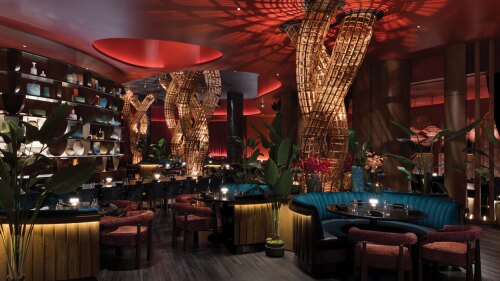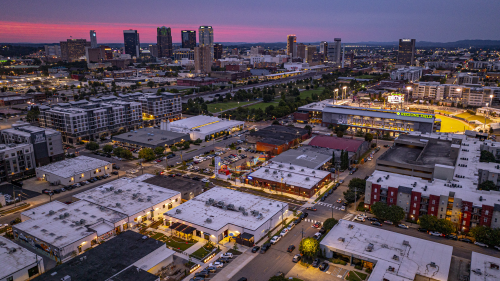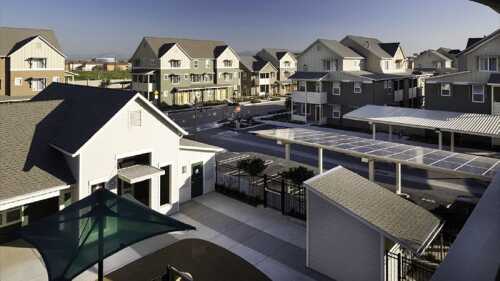Property Types
Hotels and Resorts
The hotel industry in the United States faces complex challenges in 2025, according to Jan Freitag, national director of hospitality analytics for the CoStar Group. During the “State of the U.S. Hotel Industry” presentation at the ULI 2025 Spring Meeting in Denver, Colorado, Freitag highlighted the challenges facing the hotel business amid macroeconomic uncertainty.
Once a sprawling expanse of uncharted land, Las Vegas, Nevada, has evolved into the entertainment capital of the world, a gaming super-hub, and a premier destination for sports. This remarkable transformation didn’t happen overnight; it stemmed from decades of strategic planning, investment, and visionary zoning recommendations.
Las Vegas is unlike any other place in America. Each year it draws more than 40 million visitors to the dazzling casinos and hotels that “turn night into daytime”—and transform the city into a glittering jewel in the desert. With 164,000 hotel rooms, Las Vegas is the largest hospitality market in the U.S.—outpacing Orlando, Florida, the next biggest market, by approximately 15 percent, according to JLL.
Industrial
Standing in the shadow of Regions Field and within earshot of Railroad Park, Birmingham’s Urban Supply hints at what the next chapter of downtown life could look like. Once-quiet brick warehouses are being steadily reimagined into patios, storefronts, and gathering spaces along a new pedestrian alley. Early tenants have begun to open their doors, and programming is slowly bringing people into the district. While the project is still in its early stages, the framework is in place for a vibrant hub that will grow block by block in the years ahead.
What trends are shaping the future of the industrial sector? Four experts from ULI’s Industrial and Office Park Development Council talk about the industrial submarkets and property types that offer the greatest opportunities, challenges developers face in bringing new projects to market, ways artificial intelligence and emerging technologies are reshaping the sector, tenant priorities, and other key trends.
After a quiet first half of 2024, CMBS originations increased 59 percent in Q3 on a year-over-year basis, according to the Mortgage Bankers Association’s Quarterly Survey.
Mixed-Use
Small, mixed-use infill projects are becoming favorites of the planning and development industry because of their compact urban scale, innovative design, and positive impact as catalysts for their neighborhoods.
Given the demographic and behavioral shifts, as well as the supply competition, expected to continue after the economic recovery, what steps should small cities take to boost their downtowns?
Miami’s new code, known as Miami 21, marks the first time a form-based code has been adopted for an entire major U.S. city, and it is likely to accelerate the trend.
Multifamily
As congregations across North America grapple with shrinking membership and aging facilities, a new opportunity is emerging: transforming faith-owned land into affordable housing and community-serving spaces. At the 2025 ULI Fall Meeting in San Francisco, panelists in the session “Spiritual Brownfields: Declining Congregations and Opportunities for Housing on Faith-Owned Land” explored how churches and developers are partnering to bring mission-driven housing to underused sacred sites.
At the 2025 ULI Fall Meeting in San Francisco, leaders from across the development and construction industries discussed how they are adapting to a volatile yet stabilizing housing landscape in a session called “Report from the Field: Wrestling with the Cost of Housing Construction.” Despite headlines about tariffs, labor shortages, and inflation, the panelists agreed that the cost environment has settled into what one called a “new normal.”
A panel of insiders reveals what’s true—and false—about the housing crisis and how to fix it.
Office
Before the economy crashed, commercial property owners thought long and hard about retrofitting their properties for efficiency and environmental reasons. But today, survival has become building owners’ overriding goal, with deep-diving retrofits slipping down—or off—the list of priorities. Read more to learn when industry analysts expect once again to see a major spike in the retrofitting trend.
With streamlining, downsizing, outsourcing, improved technology, cloud computing, and more working from home, future demand for office space is a question on the minds of many people in the commercial real estate sector. In light of these trends, an improved economy will not necessarily result in more demand for office space. Read what challenges experts say lie ahead for office landlords.
As new technologies are creating new models of how and where people work, office developers must adapt to these changes in order to provide affordable, sustainable, and appealing workplaces for the future. At a Bisnow Media event in D.C. on June 30, panels of developers, office product providers, and office users discussed how offices are changing—and how they must continue to evolve.
Residental
The ULI Terwilliger Center for Housing has announced the winners of this year’s housing awards, a program that celebrates and promotes the exemplary efforts of real estate and public policy leaders from across the country who are working to expand affordable and workforce housing opportunities.
Across from Manhattan’s Hudson Yards project, a significant number of new and under-construction residential structures dot the New Jersey side of the Hudson’s so-called Gold Coast stretch, including three state-of-the-art mid-rise apartment buildings just completed at the 60-acre (24-ha) Lincoln Harbor mixed-use development.
A wake-up call regarding the rising tide of older Americans on course to swamp the nation’s housing resources has been issued by Harvard’s Joint Center for Housing Studies and AARP.
Retail
For decades, civic leaders have tried to revitalize Market Street, San Francisco’s central thoroughfare, only to see their efforts founder. “I sometimes call it the great white whale of San Francisco,” says Eric Tao, managing partner at L37 Development in San Francisco and co-chair of ULI San Francisco. “Every new mayor, every new planning director, every new economic development director has chased that white whale.” This year, however, an international competition of ideas hosted and run by ULI San Francisco, with support from the ULI Foundation, generated fresh momentum for reimagining the boulevard. The competition drew 173 submissions from nine countries and sparked new conversations about the future of downtown San Francisco.
The OAK project began in 2009, when a development firm set their sights on the corner of Northwest Expressway and North Pennsylvania Avenue, the state’s most important and busiest retail intersection. As the region’s only parcel capable of supporting a vertically integrated project of this scale and density, that land represented an opportunity to create something truly special.
As aging retail continue to evolve, one increasingly popular trend has been to redesign malls as town centers—recalling a time when such commercial districts were the heart and soul of a community. Mall–to–town center retrofits are emerging throughout the nation, especially in suburban communities, where pedestrian-friendly, mixed-use environments are highly attractive to millennials now raising families.
















